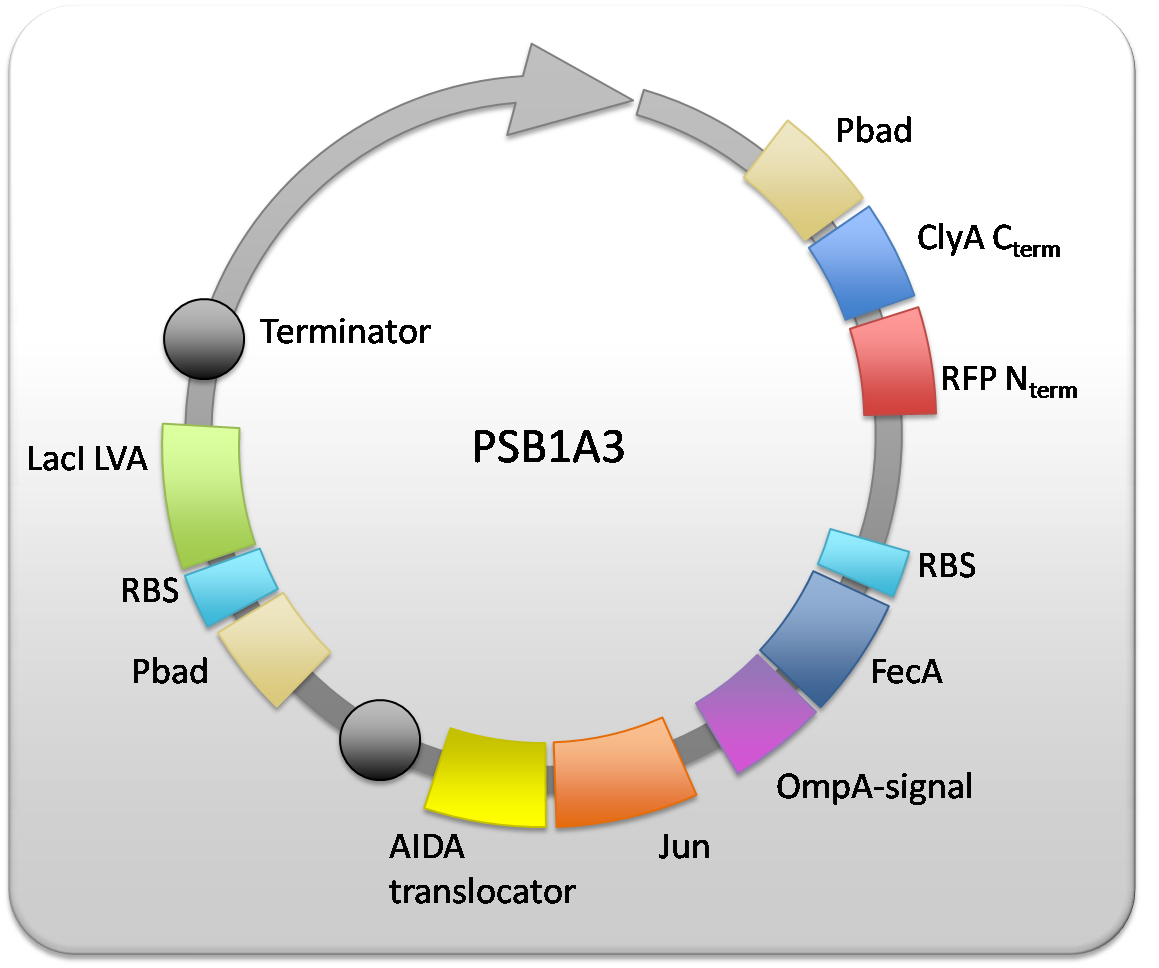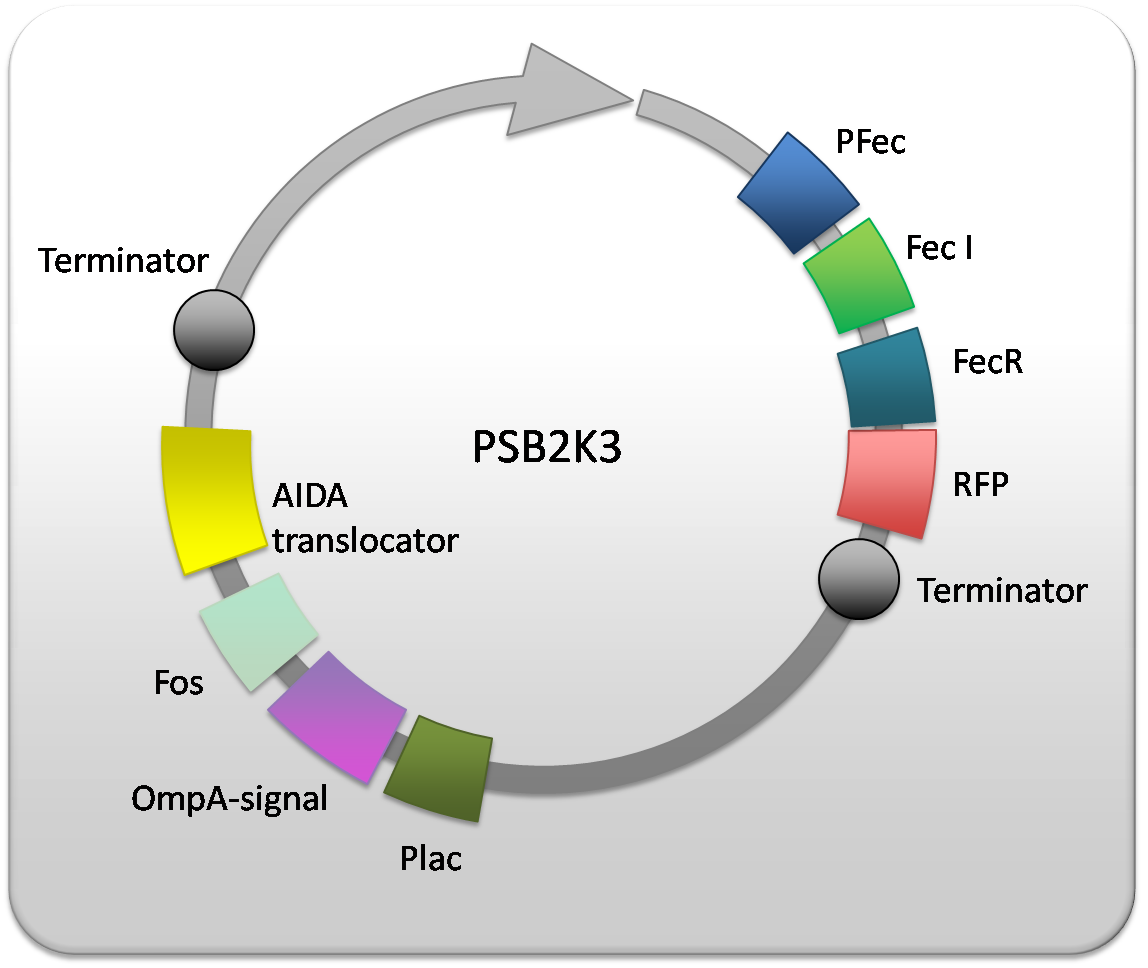Team:Paris/Project
From 2009.igem.org
David.bikard (Talk | contribs) (→A.1. The emission system) |
(→A.2. The reception system) |
||
| (63 intermediate revisions not shown) | |||
| Line 3: | Line 3: | ||
{{Template:Paris2009_menu}} | {{Template:Paris2009_menu}} | ||
== '''Overall project:''' '''''Message in a bubble'''''== | == '''Overall project:''' '''''Message in a bubble'''''== | ||
| - | |||
| - | + | <center>'''Message in a Bubble: cell-cell communication using vesicles. '''</center> | |
| - | |||
| + | <center>''Communication is a "two way" process. When you communicate you perceive the other persons responses and react with your own thoughts and feelings. It is only by paying attention to the other person that you have any idea about what to say or do next.''</center> | ||
| - | |||
| - | |||
| - | |||
| - | |||
| - | + | *''Bacterial communication:'' | |
| - | + | Bacteria communicate with another one using chemical signal molecules. As in higher organisms, the information supplied by these molecules is critical for synchronizing the activities of large groups of cells. In bacteria, chemical communication involves producing, releasing, detecting, and responding to small hormone-like molecules | |
| + | (called acylhomoserine lactones, AHL). This process, also known as quorum sensing, allows bacteria to monitor the environment for other bacteria and to alter behavior on a population-wide scale in response to changes in the number and/or species present in a community. Nevertheless, AHL molecules are broken down by other bacteria, and some AHL signals are poorly soluble in water, so '''they cannot travel far in an aqueous environment (this factor limits their potential as a long communication signals)'''. | ||
| - | |||
| - | + | *''Outer membrane vesicules in bacteria'' | |
| + | Growing '''gram-negative bacteria (like ''E.Coli'' ) release vesicles from their outer membranes as a means of delivering toxins to host cells and other bacteria'''. This mecanism is conserved among Gram-negative bacteria. The vesicles consist of a lipid bilayer surrounding an aqueous core and they can therefore transport lipid-soluble toxins (lipopolysaccharide endotoxin) on their surface and protein toxins in their core. They release their content by fusing with the lipid bilayer of target cells. | ||
| - | |||
| + | |||
| + | |||
| + | |||
| + | |||
| + | |||
| + | <center>'''''The project :'''''</center> | ||
| + | |||
| + | We decided to''' improve bacterial communication''' thanks to the vesicles formation process. In this direction our engineered communication platform consists in '''controlling OMV production''' by destabilizing membrane integrity through over-expression of specific periplasmic proteins of the Tol/Pal system. The over-production of TolR (a major protein of the Tol/Pal system which ensure the membrane integrity) has to be controled to avoid the bacteria death. | ||
| + | Another important key point of our project is to obtain a delay between the production of protein of interest and the vesicle formation, to be sure that the produced vesicles carried the different protein required for the recognition of the target bacteria and thus the one essential for the signal transduction. | ||
| + | |||
| + | |||
| + | <font color=red>Producing the messenger :</font> | ||
| + | |||
| + | In order to control and modulate message content, we used fusions with our protein of interest and OmpA signal sequence or the ClyA hemolysin as delivery tags. OmpA is a major protein of the external membrane of ''E.Coli'' and is also localize on OMVs. In this direction OmpA seems to be appropriate to deliver a specific protein to the outer membrane and, by consequence into vesicles. As OmpA, ClyA is an interesting way to explore to send protein to the external membrane. | ||
| + | |||
| + | |||
| + | <font color=red>Addressing the message :</font> | ||
| + | |||
| + | To own the communication between the donnor and the receiver a targeting system was developed. This system is based on the outer-membrane expression of Jun/Fos leucine zippers to control the vesicle flux between donor and recipient cells. Jun was mutated into its leucine zipper-motif to abolished the homodimer formation but to allow the development of heterodimer with Fos. To express these protein to the outer membrane of bacteria, they were merged with AIDA autotransporter. In this direction, the direction and the specificity of communication is controled. | ||
| + | |||
| + | |||
| + | <font color=red>Receiving the message :</font> | ||
| + | |||
| + | Once received, the signal from incoming vesicles is transduced through a modified Fec pathway, whereby the receptor is provided by the OMV. Few ABC transporter such as FecABCD (iron transporter) are able to induce a response regardless of the tranlocation, due to the activity of FecA. Moreover some mutant can also have a constitutive expression of FecABCD .So, we would like to use FecA- mutant receiver and FecA+ mutant donor to transfert the constitutive FecA protein to the receiver to transmit to the target cell the message (which comes from vesicles (bubbles)). | ||
| + | |||
| + | |||
| + | Computational models provided insight to all of the above steps and suggested directions for system improvement. '''Such reliable communications systems have wide biotechnological implications, ranging from targeted drugs delivery and detoxification to advanced division of labor or even cell-based computing.''' | ||
| + | |||
| + | |||
| + | |||
| + | |||
| + | All of our constructions are just [[Team:Paris/constructions | here]] | ||
| + | |||
| + | |||
| + | |||
| + | |||
| + | |||
| + | </div> | ||
| + | <div id="paris_content_boxtop"> | ||
| + | </div> | ||
| + | <div id="paris_content"> | ||
| + | |||
| + | |||
| + | ==='''A. Plasmid construction'''=== | ||
The plasmid construction is divided into 2 functional modules : | The plasmid construction is divided into 2 functional modules : | ||
| Line 33: | Line 72: | ||
To implement our vesicles emission project, we had to take several constrains into account. To put into place all the functionalities we needed, we designed 2 different plasmids as shown on the image below. | To implement our vesicles emission project, we had to take several constrains into account. To put into place all the functionalities we needed, we designed 2 different plasmids as shown on the image below. | ||
| + | |||
<font color=red>Writing the message: production of signaling proteins </font><br> | <font color=red>Writing the message: production of signaling proteins </font><br> | ||
| Line 39: | Line 79: | ||
To create this delay between the creation of proteins and the production of vesicles, we designed a regulatory cascade consisting of the LacI and TetR repressors. The LacI biobrick is placed in the first plasmid, downstream the pBad promoter and once synthesized acts as a repressor on the pLac promoter. The pLac promoter in the second plasmid then stops expressing TetR. The ptet promoter is then no longer repressed and the creation of non functional TolR can start leading to the emission of vesicles. | To create this delay between the creation of proteins and the production of vesicles, we designed a regulatory cascade consisting of the LacI and TetR repressors. The LacI biobrick is placed in the first plasmid, downstream the pBad promoter and once synthesized acts as a repressor on the pLac promoter. The pLac promoter in the second plasmid then stops expressing TetR. The ptet promoter is then no longer repressed and the creation of non functional TolR can start leading to the emission of vesicles. | ||
| - | |||
| - | |||
| + | <font color=red>Preparing the messenger: creation of the vesicles </font><br> | ||
As the creation of vesicles via the over-expression of TolR disturbs the membrane integrity and can create an important cell lysis, it appeared very important to find a way to avoid a long lasting expression of our TolR biobrick once the input signal is on (presence of arabinose in the medium). | As the creation of vesicles via the over-expression of TolR disturbs the membrane integrity and can create an important cell lysis, it appeared very important to find a way to avoid a long lasting expression of our TolR biobrick once the input signal is on (presence of arabinose in the medium). | ||
| Line 47: | Line 86: | ||
| - | * In presence of Arabinose, proteins of interest are created as well as vesicles : | + | * In '''presence of Arabinose''', proteins of interest are created as well as vesicles : |
| - | + | ||
| - | + | ||
[[Image:Global_On.jpg|800px|center| Plasmid construction of the emitting bacteria]] | [[Image:Global_On.jpg|800px|center| Plasmid construction of the emitting bacteria]] | ||
| - | |||
| + | *In the '''absence of Arabinose''', the pBad promoter is repressed and there is no production of proteins nor vesicles : | ||
[[Image:Global_Off.jpg|800px|center| Plasmid construction of the emitting bacteria]] | [[Image:Global_Off.jpg|800px|center| Plasmid construction of the emitting bacteria]] | ||
| Line 62: | Line 99: | ||
====A.2. The reception system==== | ====A.2. The reception system==== | ||
| + | |||
| + | To implement our vesicles reception project, we had to take several constrains into account. To put into place all the functionalities we needed, we designed 2 different types of plasmids. | ||
| + | |||
| + | |||
| + | <font color=red>Giving the message: fusion of the vesicles with the receiver.</font><br> | ||
| + | To merge the OMVs with the targeted bacteria. We have explored two different methods : Jun/Fos dimere and G3P. <br>With Jun/Fos, after mutations into the leucine zipper motif of Jun, we fused it to AIDA to send them to the extern membrane of bacteria. <br>With G3P, we fuse it to the OmpA- Linker protein to target it at the surface of the vesicles. | ||
| + | |||
| + | <br> | ||
| + | <br> On the first plasmid '''donnor''', the part wich interest us is : the fusion system part 1 | ||
| + | <br> it include the sequence : RBS / FecA / OmpA signal / Jun / AidA translocator / ter | ||
| + | |||
| + | |||
| + | [[Image:PSB1A3paris.png|500px|center]] | ||
| + | |||
| + | |||
| + | <br>On the plasmid '''receiver''', the part wich interest us is : the fusion system part 2 | ||
| + | <br> it include the sequence : plac / OmpA-signal / Fos / AidA translocator / ter | ||
| + | |||
| + | [[Image:PSB2K3paris.png|500px|center]] | ||
| + | |||
| + | |||
| + | <font color=red>Transduction: decryption of the message.</font> | ||
| + | <br> | ||
| + | We plan to use FecA- mutant receiver and FecA+ mutant donor to transfert the constitutive FecA protein to the receiver. In this case the receiver will express the FecABCD operon without being induce by ferric citrate in the medium , and so we could place under the control of the Fec ABCD promoter, which is called pfec, the gene sequence encoding for the response. For the moment a response that would be easy to detect is the fluorescence of the RFP and the biobrick BBa-J61002 is the perfect candidate to test the system. | ||
| + | <br> | ||
| + | We also discovered that some fecR and fecI mutants can be use to amplify the signal because they have a constitutive activity. So we put under the control of pfec a FecR and FecI mutated. When they will be expressed, they will be activators of pfec and consequently of RFP. Normaly we would be able to obtain a increasing fluorescence. | ||
| + | |||
| + | <br> | ||
| + | <br>On the plasmid '''receiver''', the the sequences wich interest us are : the fec proteins (transduction) and the promotor pFec (amplification response) | ||
| + | |||
| + | |||
| + | [[Image:PSB2K3paris.png|500px|center]] | ||
| + | |||
<html> | <html> | ||
| Line 70: | Line 140: | ||
</html> | </html> | ||
| - | |||
| - | |||
| - | |||
| - | |||
| - | |||
| - | |||
| - | |||
| - | |||
| - | |||
| - | |||
| - | |||
| - | |||
| - | |||
| - | |||
| - | + | {{Template:Paris2009_guided2|#top|/DryLab}} | |
| - | + | ||
Latest revision as of 04:00, 22 October 2009
iGEM > Paris > Home > OMV Project
Contents |
Overall project: Message in a bubble
- Bacterial communication:
Bacteria communicate with another one using chemical signal molecules. As in higher organisms, the information supplied by these molecules is critical for synchronizing the activities of large groups of cells. In bacteria, chemical communication involves producing, releasing, detecting, and responding to small hormone-like molecules (called acylhomoserine lactones, AHL). This process, also known as quorum sensing, allows bacteria to monitor the environment for other bacteria and to alter behavior on a population-wide scale in response to changes in the number and/or species present in a community. Nevertheless, AHL molecules are broken down by other bacteria, and some AHL signals are poorly soluble in water, so they cannot travel far in an aqueous environment (this factor limits their potential as a long communication signals).
- Outer membrane vesicules in bacteria
Growing gram-negative bacteria (like E.Coli ) release vesicles from their outer membranes as a means of delivering toxins to host cells and other bacteria. This mecanism is conserved among Gram-negative bacteria. The vesicles consist of a lipid bilayer surrounding an aqueous core and they can therefore transport lipid-soluble toxins (lipopolysaccharide endotoxin) on their surface and protein toxins in their core. They release their content by fusing with the lipid bilayer of target cells.
We decided to improve bacterial communication thanks to the vesicles formation process. In this direction our engineered communication platform consists in controlling OMV production by destabilizing membrane integrity through over-expression of specific periplasmic proteins of the Tol/Pal system. The over-production of TolR (a major protein of the Tol/Pal system which ensure the membrane integrity) has to be controled to avoid the bacteria death. Another important key point of our project is to obtain a delay between the production of protein of interest and the vesicle formation, to be sure that the produced vesicles carried the different protein required for the recognition of the target bacteria and thus the one essential for the signal transduction.
Producing the messenger :
In order to control and modulate message content, we used fusions with our protein of interest and OmpA signal sequence or the ClyA hemolysin as delivery tags. OmpA is a major protein of the external membrane of E.Coli and is also localize on OMVs. In this direction OmpA seems to be appropriate to deliver a specific protein to the outer membrane and, by consequence into vesicles. As OmpA, ClyA is an interesting way to explore to send protein to the external membrane.
Addressing the message :
To own the communication between the donnor and the receiver a targeting system was developed. This system is based on the outer-membrane expression of Jun/Fos leucine zippers to control the vesicle flux between donor and recipient cells. Jun was mutated into its leucine zipper-motif to abolished the homodimer formation but to allow the development of heterodimer with Fos. To express these protein to the outer membrane of bacteria, they were merged with AIDA autotransporter. In this direction, the direction and the specificity of communication is controled.
Receiving the message :
Once received, the signal from incoming vesicles is transduced through a modified Fec pathway, whereby the receptor is provided by the OMV. Few ABC transporter such as FecABCD (iron transporter) are able to induce a response regardless of the tranlocation, due to the activity of FecA. Moreover some mutant can also have a constitutive expression of FecABCD .So, we would like to use FecA- mutant receiver and FecA+ mutant donor to transfert the constitutive FecA protein to the receiver to transmit to the target cell the message (which comes from vesicles (bubbles)).
Computational models provided insight to all of the above steps and suggested directions for system improvement. Such reliable communications systems have wide biotechnological implications, ranging from targeted drugs delivery and detoxification to advanced division of labor or even cell-based computing.
All of our constructions are just here
A. Plasmid construction
The plasmid construction is divided into 2 functional modules :
- The emission system, which aims at producing vesicules.
- The reception system of the signal sent via the vesicules.
A.1. The emission system
To implement our vesicles emission project, we had to take several constrains into account. To put into place all the functionalities we needed, we designed 2 different plasmids as shown on the image below.
Writing the message: production of signaling proteins
First of all, before sending vesicles into the surrounding medium, we have to make sure that every molecule and protein that has to be inside the vesicles is already into place before the bacteria starts the creation of vesicles. In other words, the "emitting" bacteria must produce the proteins of interest, the export systems, the FecA proteins as well as the fusion mechanism before creating vesicles.
To create this delay between the creation of proteins and the production of vesicles, we designed a regulatory cascade consisting of the LacI and TetR repressors. The LacI biobrick is placed in the first plasmid, downstream the pBad promoter and once synthesized acts as a repressor on the pLac promoter. The pLac promoter in the second plasmid then stops expressing TetR. The ptet promoter is then no longer repressed and the creation of non functional TolR can start leading to the emission of vesicles.
Preparing the messenger: creation of the vesicles
As the creation of vesicles via the over-expression of TolR disturbs the membrane integrity and can create an important cell lysis, it appeared very important to find a way to avoid a long lasting expression of our TolR biobrick once the input signal is on (presence of arabinose in the medium).
To solve this problem, we decided to place a tag on the LacI protein to speed up its degradation. As a consequence, once the arabinose in the medium is depleted, LacI production stops and the remaining LacI is rapidly degraded. The production of TetR can resume and inhibit vesicle production.
- In presence of Arabinose, proteins of interest are created as well as vesicles :
- In the absence of Arabinose, the pBad promoter is repressed and there is no production of proteins nor vesicles :
A more accurate description of the parts used at each step of the creation process (including links to the parts registry and references) can be found in the different subdivision of the project.
A.2. The reception system
To implement our vesicles reception project, we had to take several constrains into account. To put into place all the functionalities we needed, we designed 2 different types of plasmids.
Giving the message: fusion of the vesicles with the receiver.
To merge the OMVs with the targeted bacteria. We have explored two different methods : Jun/Fos dimere and G3P.
With Jun/Fos, after mutations into the leucine zipper motif of Jun, we fused it to AIDA to send them to the extern membrane of bacteria.
With G3P, we fuse it to the OmpA- Linker protein to target it at the surface of the vesicles.
On the first plasmid donnor, the part wich interest us is : the fusion system part 1
it include the sequence : RBS / FecA / OmpA signal / Jun / AidA translocator / ter
On the plasmid receiver, the part wich interest us is : the fusion system part 2
it include the sequence : plac / OmpA-signal / Fos / AidA translocator / ter
Transduction: decryption of the message.
We plan to use FecA- mutant receiver and FecA+ mutant donor to transfert the constitutive FecA protein to the receiver. In this case the receiver will express the FecABCD operon without being induce by ferric citrate in the medium , and so we could place under the control of the Fec ABCD promoter, which is called pfec, the gene sequence encoding for the response. For the moment a response that would be easy to detect is the fluorescence of the RFP and the biobrick BBa-J61002 is the perfect candidate to test the system.
We also discovered that some fecR and fecI mutants can be use to amplify the signal because they have a constitutive activity. So we put under the control of pfec a FecR and FecI mutated. When they will be expressed, they will be activators of pfec and consequently of RFP. Normaly we would be able to obtain a increasing fluorescence.
On the plasmid receiver, the the sequences wich interest us are : the fec proteins (transduction) and the promotor pFec (amplification response)
 "
"



